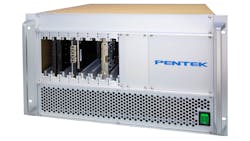SOSA-Aligned Dev Platform Speeds System Integration
If you’re developing and integrating systems that mesh with the Sensor Open Systems Architecture (SOSA) technical standard, you might be interested in Pentek’s model 8256 development platform. The platform, which is aligned to the SOSA standard, is a 3U VPX platform with Intelligent Platform Management Interface (IPMI) and connectivity for RF and optical interfaces. The Model 8256 is built for application development with Pentek's Quartz RFSoC data acquisition and processing boards. Pentek's SOSA-aligned products facilitate interoperability, re-use, and rapid technology insertion, all consistent with the SOSA Consortium’s approach and vision.
Several Pentek partners and key contributors to the emerging SOSA Technical Standard are involved in the development of this platform. Pentek teamed with Elma Electronic for backplane and system management components, Interface Concept for backplane switch modules, Concurrent Technologies for single board computer modules, and Crossfield Technology for IPMI and chassis management support; all specifically designed to be in alignment with the SOSA Technical Standard.
The Open Group SOSA Consortium created a common framework, the emerging SOSA Technical Standard, for sensor systems based on key interfaces and open standards established by industry-government consensus. The forthcoming SOSA Technical Standard implements numerous VITA standards that are reflected in the Pentek Model 8256 configuration. The Model 8256 takes advantage of several advanced features including cooling, platform system management and RF/optical interface options. Advanced Features
For one, the Model 8256’s built-in forced-air cooling is designed to support conduction-cooled boards in a standard 19” rackmount profile chassis. This provides the convenience of development on conduction-cooled boards in a desktop or laboratory environment. The development chassis utilizes VITA 46.11- and HOST-aligned Chassis Management Module (CMM). This CMM is software-upgradeable to the forthcoming SOSA v1.0 standards. SOSA-aligned systems will feature, and the CMM will enable, meaningful integration between the functional elements (SOSA Modules) and the System Manager, the CMM, and every Plug-In Card (PIC).
Model 8256 is designed for convenient access to RF and optical interfaces. Each RF payload slot can be optioned with 20 coaxial breakout connectors located on the back panel of the chassis, providing direct connections to the VITA 67.3C backplane connector. In addition, each RF payload slot can be optioned with two rear-panel MPO adapters to provide access to the VITA 67.3C dual optical interfaces.
The Model 8256 is immediately available. Several options for Quartz RFSoC data acquisition and processing boards, RF and optical interconnections are possible. Pentek integration assistance is available to select and configure modules that are most appropriate for prototyping specific applications.
About the Author
David Maliniak
Executive Editor, Microwaves & RF
I am Executive Editor of Microwaves & RF, an all-digital publication that broadly covers all aspects of wireless communications. More particularly, we're keeping a close eye on technologies in the consumer-oriented 5G, 6G, IoT, M2M, and V2X markets, in which much of the wireless market's growth will occur in this decade and beyond. I work with a great team of editors to provide engineers, developers, and technical managers with interesting and useful articles and videos on a regular basis. Check out our free newsletters to see the latest content.
You can send press releases for new products for possible coverage on the website. I am also interested in receiving contributed articles for publishing on our website. Use our contributor's packet, in which you'll find an article template and lots more useful information on how to properly prepare content for us, and send to me along with a signed release form.
About me:
In his long career in the B2B electronics-industry media, David Maliniak has held editorial roles as both generalist and specialist. As Components Editor and, later, as Editor in Chief of EE Product News, David gained breadth of experience in covering the industry at large. In serving as EDA/Test and Measurement Technology Editor at Electronic Design, he developed deep insight into those complex areas of technology. Most recently, David worked in technical marketing communications at Teledyne LeCroy, leaving to rejoin the EOEM B2B publishing world in January 2020. David earned a B.A. in journalism at New York University.

